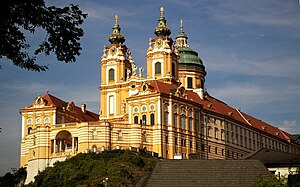Melk Abbey


Melk Abbey or Stift Melk is an Austrian Benedictine abbey, and one of the world's most famous monastic sites. It is located above the town of Melk on a rocky outcrop overlooking the river Danube in Lower Austria, adjoining the Wachau valley.
The abbey was founded in 1089 when Leopold II, Margrave of Austria gave one of his castles to Benedictine monks from Lambach Abbey. A school was founded in the 12th Century, and the monastic library soon became renowned for its extensive manuscript collection. The monastery was also a major site for the production of manuscripts. In the 15th Century the abbey became the centre of the Melk Reform movement which reinvigorated the monastic life of Austria and Southern Germany.
Today's impressive Baroque abbey was built between 1702 and 1736 by architect Jakob Prandtauer. Particularly noteworthy is the abbey church with frescos by Johann Michael Rottmayr and the impressive library with countless medieval manuscripts and frescos by Paul Troger.
Due to its fame and academic stature, Melk managed to escape dissolution under Emperor Joseph II when many other Austrian abbeys were seized and dissolved between 1780 and 1790. The abbey managed to survive other threats to its existence during the Napoleonic Wars, and also in the period following the Nazi Anschluss (takeover) of Austria in 1938, when the school and a large part of the abbey were confiscated by the state.
The school was returned to the abbey after the Second World War and now caters for nearly 900 pupils of both sexes.
Since 1625 the abbey has been a member of the Austrian Congregation, now within the Benedictine Confederation.
Umberto Eco named one of the protagonists in his well-known novel The Name of the Rose as a tribute to the abbey and its famous library "Adso von Melk".
Photos
-
Church of the Abbey.
-
Ceiling of the church, with frescos.
-
Cupola of the church.
-
The Triumph of the Monk, by Johann Michael Rottmayr.
-
St. Benedicts triumphal ascent to Heaven, also by Rottmayr
-
Painting on the ceiling of the marble hall
-
The library
-
Melk Abbey in 1672, before its renovation by Jakob Prandtauer.
See also
- Melk Abbey was recently selected as the main motif of a very high value collectors' coin: the Austrian Melk Abbey commemorative coin, minted in April 18 2007. The obverse shows a view up to the façade of the abbey church and its two side wings from a low level. The twin baroque towers and the great dome of the church behind them can be seen. In the lower right corner the coat-of-arms of the Abbey of Melk (the crossed keys of St. Peter) can be seen.
External links with English content
- Melk Abbey- Official website
 Herbermann, Charles, ed. (1913). "Abbey and Congregation of Melk". Catholic Encyclopedia. New York: Robert Appleton Company.
Herbermann, Charles, ed. (1913). "Abbey and Congregation of Melk". Catholic Encyclopedia. New York: Robert Appleton Company.








